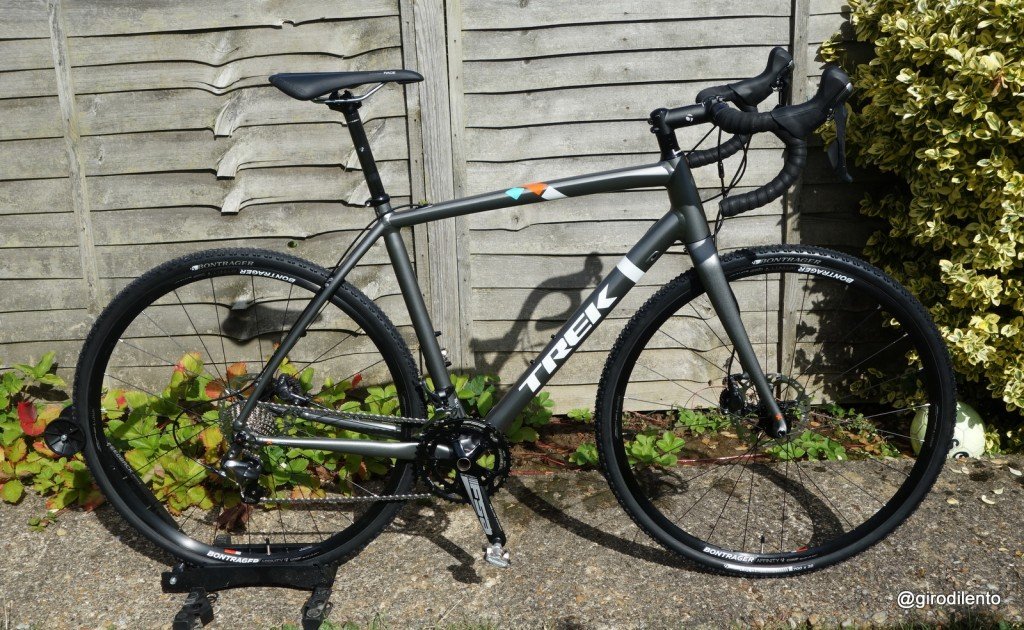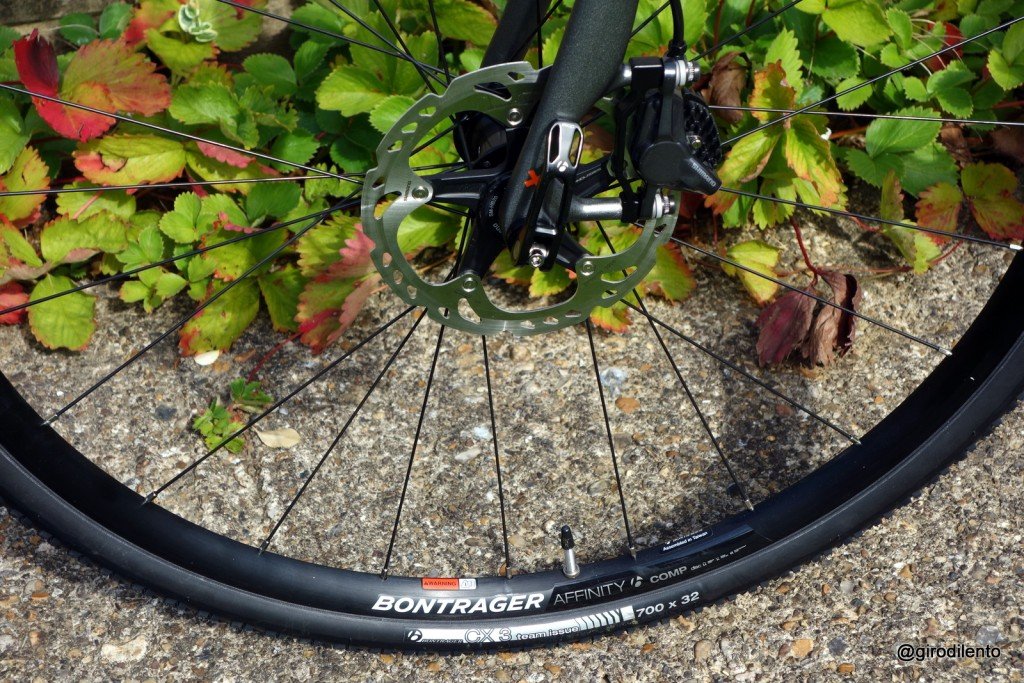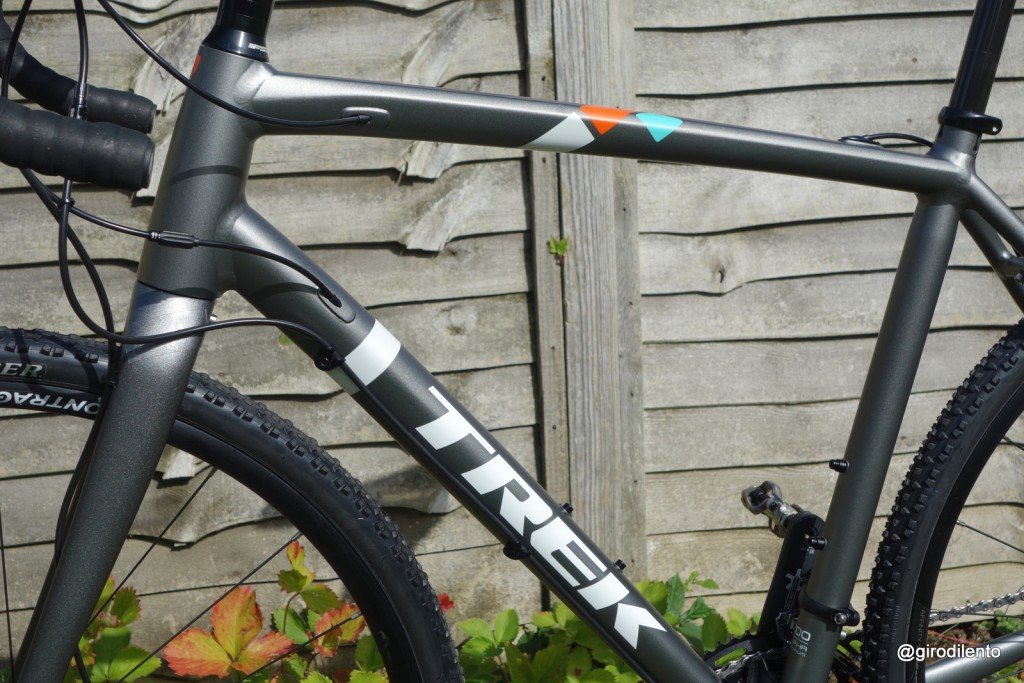I’ve been riding road bikes now for about a decade. But that’s all I’ve done. I’ve not ridden mountain bikes and I’ve not ridden Cyclocross apart from one event a few years ago: the White Chalk Hills UCX.
As the years have past, I’ve got keener and keener to get a bit muddier and I’ve had lots of debates with various friends in the bike trade about what my first steps off road should be. Like most of us, once I’d realised how much fun riding bikes is, it was only a question of time before I began thinking about what other kind of riding I could do to have more and different fun.
The obvious answer is ride off road, so it’s absolutely perfect that Trek’s stylish Crockett 9 recently arrived for some adventuring.
The Crockett has been around for a few years now and perhaps has fallen out of the limelight a touch after the arrival of the IsoSpeed equipped carbon Boone, but it’s still a bike with fantastic pedigree. Trek’s champion ‘cross rider Katie Compton had an important influence in its development and it’s a World Cup winning platform.
Looking at the geometry first, the Crockett it has a very similar stack and reach to my road bikes but the bottom bracket is a touch higher (for obvious reasons) and the head angle is a bit slacker, which also makes sense. As someone, who doesn’t race and doesn’t really need super long and low positioning, the higher stack height of the Crockett compared to some of its competitors is very appealing.
The Crocket range has a number of choices that should work for most budgets. The Crockett 9 that I have to test is the top of the range and retails for £2,200 but the range starts with the frameset only from £600. There’s a 105 spec complete Crockett 5 disc for £1,250 and a cantilever brake Crockett 7 for £1,450. The range should allow almost anyone to find a spec and a pricepoint that works for them. We’ll come back to pricing later.
Looking at the Crockett 9 that I have here in more detail, the frame is made with Trek’s 200 series Alpha Aluminium and features a tapered head tube, BB86 Bottom Bracket, internal control (gear cable) routing, post mount disc brakes, a chain keeper and hidden mudguard mounts. On this model, the Crockett 9, the fork is Trek’s IsoSpeed cross carbon disc version with a full carbon steerer and a 15mm through axle. Please note though that this is the only Disc braked model in the Crockett range with the full carbon fork (the Boone has the same fork approach too – only the top model has the full carbon fork, all the rest have alloy steerers. On both models the canti braked version have a full carbon fork).
The frame looks to have good clearance for mud/wider tyres particularly at the seatstays and fork. It looks a bit tighter around the chainstays to me. No problem for the 33mm tyres fitted but if you wanted to go to 40mm tyres for example, it might be a bit tight.
As the top of the range, the Crockett 9 to my mind has the best paint scheme in the range, the Matt Charcoal is a stunning paint colour and most people who’ve seen the bike have mistakenly assumed it was carbon, which depending on your point of view might be a good thing too. The white detailing looks great and I love the look of the bike.
A key component is the brakes and this bike has Shimano’s frankly fantastic RS685 shifters and hydraulic disc brakes. These are still an expensive component choice but they work brilliantly on the bike. The shifters are paired with Ultegra front and rear mechs, which look good and work exceptionally well. The cassette and chain are Shimano’s reliable 105 (11/28 cassette). And the cranks are FSA’s Energy Cross in 46/36. I think it would have been nice for the cranks to be Ultegra too for this retail price to be frank.
The finishing kit is all Bontrager. We have Affinity Comp Tubeless wheels with 15mm through axle front and quick release rear (a combination I like and it’s also good for pre-race warmups on your turbo trainer). The wheels are shod with Bontrager’s CX3 team issue – non tubeless 32c tyres. There’s a Bontrager carbon seatpost and Paradigm R saddle. Handlebars are Bontrager Race Lite IsoZone compact bars attached to a Bontrager Elite 100mm stem.
I tapped up some local riders who I knew rode ‘cross bikes to show me some of their loops and I’ve been out on the bike for a few rides.
The first thing that struck me was how comfortable the bike is. Yes, part of this is switch from a road bike with around 90psi to 33mm CX tyres running 40-ish psi. The second thing I noticed was how easily the geometry of the Crockett made me feel at home. It’s close enough to my road bike positioning that I didn’t have any trouble adapting to the bike.
I’ve spend a lot of time riding Shimano hydraulic disc brakes on the road, but they’re even more impressive on the Crockett. Fantastic control and modulation regardless of the conditions I’m riding through – a real joy when you’ve suddenly discovered you have to learn how to ride off road from zero. As an inexperienced rider off tarmac, I’ve quickly realised I have no skills and the Crockett has been a delight so far as it’s really easy to ride. In deep mud (which there has been lots of), I’ve found the tyres wanting a bit but I’ve enjoyed every ride so far. The geometry is stable and the bike’s handling has helped me build some confidence off road. Well at least confidence in the bike if not my own skills yet. The Crockett 9 does all the basics well as you’d expect from a major company like Trek. Cornering, climbing, descending are all handled with aplomb. In complete fairness, I don’t have much to compare it too as I’m a beginner off road but I’ve found this a very easy bike to take to.
As a roadie, it’s been fantastic to get out into the mud and there have been a couple of rides where we’ve stopped for a chat in a field, surrounded by trees, with no other humans around and it’s been terrific to be further out into nature (and away from drivers). Finding places to ride around where I live is not so easy but they’re absolutely worth the effort.
My inability off-road has seen me crash on nearly every ride but it’s all be relatively low speed stuff and part of the learning experience. The Trek has a couple of scuffs on the bar tape but otherwise seems unscathed.
I’d always wondered what it’d be like to have a bike I could ride off road in my fleet and so far it has expanded my flexibility to go on different types of rides and it’s expanding my horizons a bit too, which is very welcome.
So far, I’m thoroughly enjoying the bike and my only reservation is the price. £2,200 feels like a lot for an aluminium cyclocross bike, even for one with a pedigree. I suspect it’s priced to encourage you to stretch another £200 for the full carbon Boone (and the Boone range has a similar pricing approach). I think the £1250 Crockett 5 looks much better value but it doesn’t have the hydraulic disc brakes or the full carbon fork (or a few other spec differences). The paint job isn’t nearly as appealing either. If you can cope with the pink colour of the frameset, that is probably the best option of the lot that would allow you to build up any spec you like and I reckon I could build a comparable spec for less than the £2200 of the Crockett 9. So there are plenty of options if a Crockett is of interest. Personally I couldn’t buy the pink frameset though, I’m just not a pink sort of a guy. If it was the charcoal like the Crockett 9 – it’d be much easier!
If you can justify the asking price, I think you’re getting a bike that works incredibly well right out of the box. The Trek Crockett 9 looks great, rides really well and has a spec that works perfectly as a package. I keep looking at the bike and thinking, if this was mine, what would I change? The simple truth is, I wouldn’t change anything, I’d just enjoy riding it. For now that’s what I’m doing. I’m going to keep riding it and see if these impressions change. Price aside, my initial impressions of the Trek Crockett 9 are very positive indeed. It’s been a fun bike to ride and fine companion on some off-road adventures.
My next test will be to put some different wheels and some 28mm road tyres on it to see how it doubles as a winter road bike. I’ll write more about that in my next post on this bike.
Thanks for reading.
UPDATE MARCH 11 2016: I’ve now published my final review here: http://girodilento.com/trek-crockett-9-review/
You can find out more about the Crockett Range here: http://www.trekbikes.com/uk/en/bikes/road/cyclocross/crockett/
You can read another review here that gives more of a racing perspective:












